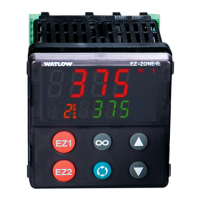Watlow EZ-ZONE
®
PM Integrated Controller • 109 • Chapter 9 Features
Cascade Control
The PM (PM8/9) can be configured for Cascade con-
trol with enhanced firmware. Cascade control is a
control strategy in which one control loop provides
the set point for another loop. It allows the process or
part temperature to be reached quickly while mini-
mizing overshoot. Cascade is used to optimize the
performance of thermal systems with long lag times.
The graph to the right illustrates a thermal system
with a long lag time.
Curve A represents a single loop control system with
PID parameters that allow a maximum heat up rate.
Too much energy is introduced and the set point is
overshot. In most systems with long lag time, the
process value may never settle out to an acceptable
error. Curve C represents a single control system
tuned to minimize overshoot. This results in unac-
ceptable heat up rates, taking hours to reach the
final value. Curve B shows a cascade system that
limits the energy introduced into the system, allow-
ing an optimal heat up rate with minimal overshoot.
Cascade control uses two control loops (outer and
inner) to control the process. The outer loop (analog
input 2) monitors the process or part temperature,
which is then compared to the set point. The result
of the comparison, the error signal, is acted on by the
PID settings in the cascade outer loop, which then
generates a power level for the outer loop. The set
point for the inner loop is determined by the outer
loop power level. The inner loop (Analog Input 2)
monitors the energy source (heating and cooling),
which is compared to the inner loop set point gener-
ated by the outer loop. The result of the comparison,
the error signal, is acted on by the PID settings in
the cascade inner loop, which generates an output
power level between -100% to +100%. If the power
level is positive the heat will be on; if the power level
is negative the cool will come on. Power from the en-
ergy sources are supplied by the outputs of choice.
Compressor Control
The PM (PM8/9) can be configured for Compressor
control with enhanced firmware. The compressor
control can save wear on a compressor and prevent
it from locking up from short cycling. A bypass valve
operated by a control output regulates how the pro-
cess is cooled, while another output switches the com-
pressor on and off. The compressor will not turn on
until the output power exceeds the Compressor On
% Power for a time longer than the Compressor On
Delay. The compressor will not turn off until the out-
put power exceeds the Compressor Off % Power for a
time longer than the Compressor Off Delay.
Time
Temperature
Cascade
Curve A (PID)
Set
Point
Curve B (Cascade)
Curve C (Single-control)
0% Compressor
On Power
Off
On
100%
2%
0%
-100%
Compressor On Delay = 45 Seconds
Compressor Off Delay = 20 Seconds
2% Compressor
Off Power
Time In Seconds
% Power
Heat
Cool
Compressor
Note:
See Chapter 10 for application examples.

